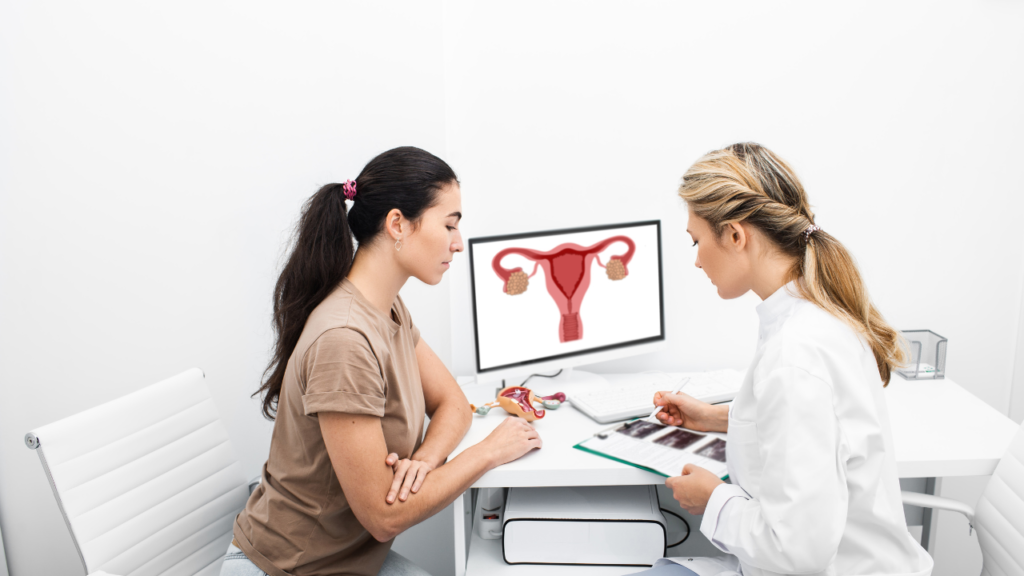
The endometrium is a layer that covers the uterus. Every month, when the ovaries release an egg, the endometrial thin uterine lining gets thicker to prepare for a possible pregnancy. If the egg doesn’t get fertilized, the lining sheds and leaves the body through the vagina. The lining is important for supporting an embryo and is needed for pregnancy. When the lining is thin, usually less than 7mm, the body can’t support an embryo or a growing baby.
Where Is the Lining?
The endometrial lining is situated in the uterus’s deepest layer, a hollow, pear-shaped organ located in a woman’s pelvis.
Endometrial lining Function
In the endometrial lining a developing embryo attaches during the early days of pregnancy. When a woman undergoes IVF (In Vitro Fertilization), the thickness of this lining is very important. The fertility doctor will check the thickness of the lining before transferring the embryo to make sure it is thick enough for implantation.
It’s best for the lining to be at least 7 to 8mm thick and show a “trilaminar” or “three-layered” appearance on an ultrasound. This kind of lining provides a good environment for the embryo to grow, as it is thick, receptive, and nourishing.
Thin uterine lining symptoms
Problems with having a thin uterine lining often happen for many years before women try to get pregnant. However, women may not realize there is an issue with their endometrium until they receive proper testing. Women who have a thin endometrial lining might need to go through several rounds of IVF (In Vitro Fertilization). Here are some signs that could indicate a thin endometrial lining:
- Abnormal periods
- Painful periods or cramps
- Trouble carrying a fetus to full-term
Causes of thin uterine lining

Having a thin uterine lining can be a significant issue during IVF, as it can result in failed embryo implantation or irregularities in the lining that cause early pregnancy loss. There are several reasons why a woman may have a thin lining. Some causes include:
- Not having enough estrogen
- Insufficient blood flow to the uterus
- Presence of uterine fibroids
- Adhesions or scar tissue in the uterus caused by previous trauma or infection
- Hydrosalpinx (a condition where the fallopian tube is blocked and filled with fluid)
- Chronic endometritis (an infection of the cells lining the uterus)
If your doctor finds that a specific anatomical issue may be causing a thin endometrium, they may recommend treating that problem before you try to get pregnant. For instance, minimally invasive surgery can be performed to remove fibroids or fix a hydrosalpinx. In the case of endometritis, antibiotics can help. In the case of other issues, the usual treatment involves using additional estrogen supplements and implementing methods to improve blood circulation in the pelvic region.
It is possible to conceive with perfect lining for embryo transfer of 7 to 8mm, but for the best chances of success, your doctor might suggest trying to thicken and Enhance the quality of your uterine lining before the embryo transfer procedure. Here are some ways to promote the growth of your endometrium.
How to thicken uterine lining?
Having a thin uterine lining is not a permanent condition. In fact, there are natural methods to enhance the thickness of the uterine lining during the process of trying to conceive.
Boosting Physical Activity Levels for Improved Health
Engaging in more physical activity can help address the issue of a thin endometrial lining. Poor blood circulation can be a cause of a thin uterine lining. In fact, a lack of physical activity contributes to this condition. Exercise offers various benefits to the body, and even something as simple as walking can promote the thickening of the uterine lining. It is recommended to increase overall activity levels and aim for at least 15-20 minutes of daily physical activity.
Consume herbal supplements
Taking herbal supplements is a good way to give your body important nutrients and improve blood flow. Women can also use supplements to boost their estrogen levels. Estrogen is a very important hormone for reproductive health, and having low estrogen levels can cause a thin uterine lining. Some herbal supplements like red clover, royal jelly, and maca root contain phytoestrogens, which help increase estrogen levels. Other supplements like raspberry leaf, rose hips, and hibiscus flower can help improve blood circulation.
Enhance your period regularity by building up your endometrial lining. Join the Confident Hormone Club for DR. Kaylee’s guidance, personalized strategies, and a supportive community. Take charge of your menstrual health today and experience improved cycles with us.
MASSAGES
Giving your body a physical massage can be beneficial in stimulating tired nerves and muscles. External massage on the abdominal area specifically can help strengthen the muscles of the uterus and detoxify the reproductive organs. It is recommended to consult a licensed physical therapist or massage therapist who can provide this type of therapy.
How naturopathic doctor helps to thicken the uterus lining?
Naturopathic doctors may suggest natural remedies like dietary adjustments, massage, and acupuncture to help increase the thickness of the uterine lining. During The Confident Hormone Program, Dr. Kaylee will prescribe natural remedies and write letters to your family physician to have them aid you in getting the appropriate imaging and bloodwork to support preparing for an optimal pregnancy. To consult with Dr. Kaylee Alton book a discovery call or visit https://makecarehealth.com/ for more details.
How to thicken uterine lining in 48 hours?
There are multiple methods available to increase the thickness of the uterine lining. Nevertheless, it’s crucial to understand that it’s not feasible to achieve significant thickening within just 48 hours. The process of thickening the uterine lining and preparing it for implantation takes time.
How to cleanse the uterus after a period naturally?
For natural cleansing of the uterus after periods, you can follow these practices:
- Wear loose clothing and cotton underwear to allow better airflow and prevent excessive heat.
- Use mild soap and water daily to cleanse the external vaginal and pubic areas, ensuring any residual blood is removed and odors are reduced.
- Some herbs like ginger, marigold, motherwort, raspberry, nettle leaves, and goldenseal root are suggested for womb cleansing.
Also you can use Yoni steaming, a practice involving sitting over a pot of steaming water infused with herbs, is reputed to offer several benefits, including reducing menstrual cramps, promoting fertility, and alleviating menopausal symptoms. Follow these instructions for a yoni steam:
- Fill a medium-sized pot with water.
- Set the pot on the stove and bring the water to a simmer.
- Add the desired herbs to the pot and cover it with a lid.
- Allow the herbs to simmer for a few minutes, then turn off the heat.
- Let the herbal infusion cool for approximately 5 minutes while you prepare your steaming space.
Please note that the practice of yoni steaming should be approached with caution, and it is advisable to consult with a healthcare professional before attempting it.
However, it’s important to note that there is currently no scientific evidence supporting the effectiveness of these remedies in cleansing the uterus after periods. It is advisable to consult with a medical doctor or a gynecologist for accurate diagnosis and appropriate treatment.
What is trilaminar endometrium ultrasound?
Trilaminar endometrium ultrasound refers to the appearance of the endometrial lining during an ultrasound examination. The endometrium is the inner lining of the uterus, and a trilaminar appearance is considered normal and desirable during certain phases of the menstrual cycle.
However, it’s important to note that the trilaminar appearance alone does not guarantee you will have a successful implantation or pregnancy. Other factors, such as thickness and overall health of the endometrium, are also important considerations.
What is a sonohysterogram?

A sonohysterogram is a diagnostic imaging study that provides detailed visualization of the uterus. During the procedure, your doctor will gently introduce fluid into the uterus through the cervix to examine the uterine lining. This method enables them to identify and evaluate a greater range of structures compared to a regular ultrasound without the use of fluid. By utilizing a sonohysterogram, your doctor can gather comprehensive insights into your uterine health and make more accurate assessments.
Sonohysterography is a valuable diagnostic tool employed to investigate uterine abnormalities in patients experiencing infertility or multiple miscarriages. This procedure helps identify underlying causes of various issues, including abnormal uterine bleeding, infertility, and recurrent miscarriage.
By utilizing sonohysterography, healthcare professionals can detect and assess abnormal growths like fibroids or polyps inside the uterus, providing valuable information about their size and depth. Additionally, this technique enables the examination of scar tissue within the uterus, offering insights into its presence and extent. Sonohysterography plays a crucial role in understanding and addressing uterine concerns to support improved reproductive health outcomes.

